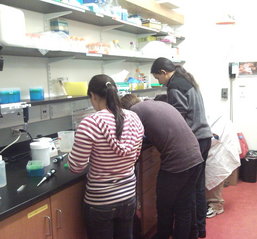Team:MIT
From 2010.igem.org
| Line 5: | Line 5: | ||
| | | | ||
In an effort to form self-assembling three-dimensional biomaterials, we are attempting two parallel paths in mammalian differentiation and phage polymerization. In mammalian cells, our goal is to induce bone formation in response to a pressure stimulus. Our system will sense mechanical stimulation via a pressure-sensitive promoter, identified by screening the fluid shear stress response of a library of candidate promoters in microfluidic devices. The activity of this promoter will feed into a bi-stable toggle circuit, optimized using a mathematical model, which will convert a transient stimulus into constitutive expression of a factor that induces bone formation. For our phage portion, we plan to induce polymer formation in bacterial cells, using UV light to control the pattern of polymer growth. In addition, we will integrate various fluorescent proteins into our system, each of which is dependent upon quorum sensing processes. Our completed project will allow for the creation of visible bacteriophage structures against a user-directed, multichromatic background. | In an effort to form self-assembling three-dimensional biomaterials, we are attempting two parallel paths in mammalian differentiation and phage polymerization. In mammalian cells, our goal is to induce bone formation in response to a pressure stimulus. Our system will sense mechanical stimulation via a pressure-sensitive promoter, identified by screening the fluid shear stress response of a library of candidate promoters in microfluidic devices. The activity of this promoter will feed into a bi-stable toggle circuit, optimized using a mathematical model, which will convert a transient stimulus into constitutive expression of a factor that induces bone formation. For our phage portion, we plan to induce polymer formation in bacterial cells, using UV light to control the pattern of polymer growth. In addition, we will integrate various fluorescent proteins into our system, each of which is dependent upon quorum sensing processes. Our completed project will allow for the creation of visible bacteriophage structures against a user-directed, multichromatic background. | ||
| - | |[[Image:MIT_team.png|right|20px|frame| | + | |[[Image:MIT_team.png|right|20px|frame|2010]] |
|- | |- | ||
| | | | ||
Revision as of 00:59, 17 July 2010
| You can write a background of your team here. Give us a background of your team, the members, etc. Or tell us more about something of your choosing. | |
|
In an effort to form self-assembling three-dimensional biomaterials, we are attempting two parallel paths in mammalian differentiation and phage polymerization. In mammalian cells, our goal is to induce bone formation in response to a pressure stimulus. Our system will sense mechanical stimulation via a pressure-sensitive promoter, identified by screening the fluid shear stress response of a library of candidate promoters in microfluidic devices. The activity of this promoter will feed into a bi-stable toggle circuit, optimized using a mathematical model, which will convert a transient stimulus into constitutive expression of a factor that induces bone formation. For our phage portion, we plan to induce polymer formation in bacterial cells, using UV light to control the pattern of polymer growth. In addition, we will integrate various fluorescent proteins into our system, each of which is dependent upon quorum sensing processes. Our completed project will allow for the creation of visible bacteriophage structures against a user-directed, multichromatic background. | |
| Team Example |
| Home | Team | Official Team Profile | Project | Parts Submitted to the Registry | Modeling | Notebook | Safety |
|---|
 "
"

